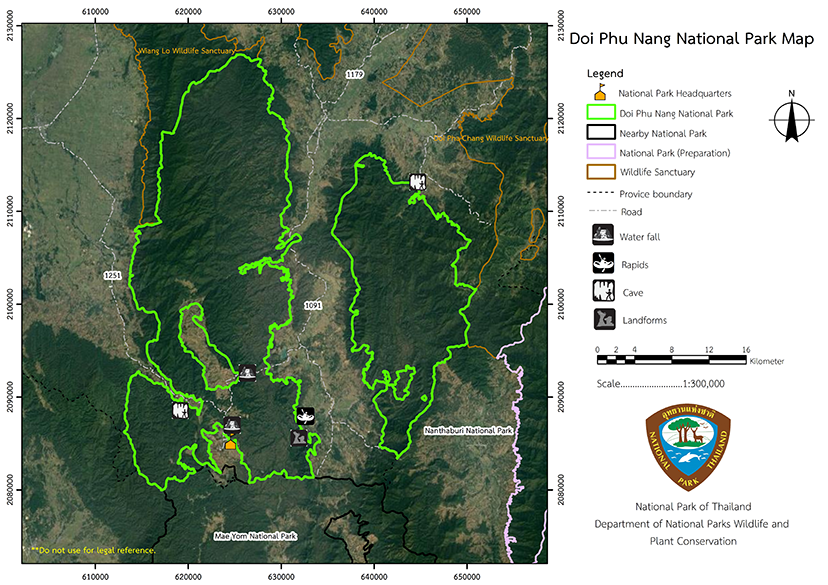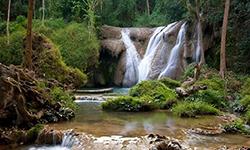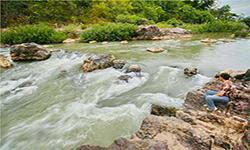Doi Phu Nang National Park
Contact Location : Doi Phu Nang National Park, Moo 6, Ban Bo Pae, Ban Mang Sub-district, Chiang Muan District, Phayao Province 56160
Telephone Number : (+66) 9 5690 0605
Email : doiphunang@outlook.com
Facebook : Doi Phu Nang National Park
Information
Doi Phu Nang National Park in Phayao Province is Thailand's 127th National Park, the announced in the Government Gazette Volume 129, Part 51 Ko on June 13th, 2012, pursuant to a Royal Decree. land area of Mae Yom Forest, Mae Tam Forest, and Mae Rong Khui Forest in the Pong, Khuan and Khun Khon Sub-district, Pong District, Ban Tham, Nong Lom and Ban Pin Sub-district, Dok Kham Tai District and Sa, Chiang Muan and Ban Mang Sub-district, Chiang Muan District, all of which are located in Phayao Province. A total area of 859.8 square kilometers is to be designated as Doi Phu Nang National Park. Doi Phu Nang National Park is located in northern Thailand between latitudes 18 degrees 90 minutes north and 19 degrees 14 minutes north and longitudes 100 degrees 6 east and 100 degrees 26 east.
Background
Minister of Agriculture and Cooperatives (Major General Sanan Kajornprasat) on February 22nd, 1990 visited the government's Forest Destruction Prevention and Suppression Center 1, at Ban Pha Cho, Nong Lom Sub-district, Dok Khamtai District, Phayao Province, issuing a policy on forest resource conservation in Phayao province, to allow Chiang Rai's forests to develop a comprehensive forest protection action plan, including reforestation and forest fire prevention by determining the total area of forest required to establish a wildlife sanctuary or National Park area, and to exclude the degraded forest areas to be governed under the Land Reform Office.
The Prevention and of Encroachment Forest Office (at the time) requested a grant from the National Park Division (at the time) for the year 1990 (additional) budget to conduct a survey. A National Park is a completely forested area. Later that year, the Chiang Rai Regional Forest Office conducted a forest area survey of the Mae Yom on the right bank Forestry Project (Cho Ro 17) Part 5 - 10, and Nam Pi Forest (Cho Ro. 38) between the dates of 1st and 30th September 2010, and prepared a report to the National Park Division, Royal Forest Department, for consideration. It is entirely appropriate for it to be designated as a National Park due to the existence of numerous advantages as a result of the area's beautiful natural surroundings and having the forest in pristine condition. Mr. Worawut Amornthat, a Forestry Technical Officer Lavel.5, conducted a survey of Mae Yom Fang-Khwa Forest and the area surrounding it in order to establish a National Park. This is to conserve the forest in order to preserve its integrity and beauty.
Doi Phu Nang National Park encompasses three national protected forests: 1) Mae Yom National Reserved Forest in the Kuan, Pong, Sa, Chiang Muan, and Ban Mang Sub-district in Chiang Muan District, Phayao Province, a national reserved forest announced in 1975, 2) Mae Tam National Reserved Forest in the Ban Pin Sub-district, Dok Khamtai District, Phayao Province, a national reserved forest announced in 1962, under the Forest Protection and Conservation Act, and 3) Mae Rong Khui National Reserved Forest in the Nong Lom Sub-district, Dok Khamtai District, Phayao Province, a national reserved forest announced in 1963, under the Forest Protection and Conservation Act.
Note : After paying the entrance fee to the National Park, please carry the receipt for inspection.
537,424 rai (859.8 square kilometers)
|
|
|
|
|
|
|
|
|
|
|
|
Nature trails ⇔ Visit Waterfall ⇔ Cave exploration/Geological condition ⇔ Camping
Welfare shop : 08:30 - 16:30 hrs.
Mobile phone signal:
National Park Headquarters area: AIS, TRUE
|
|
The area is made up of high fold mountains (complex mountain landscape) that range in elevation from 361 to 1,222 meters above sea level; the highest point is Doi Phu Nang, which is located in Pong Sub-district, Pong District in Phayao Province and is approximately 1,222 meters above sea level. The area is the catchment area for numerous creeks including Mae Phong Creek, Mae Hi Creek, Nam Mao Creek, Rong Chang Creek, Nam Mae Chau Creek, Nam Mae Pang Creek, and Kampong Luang Creek on the western side, and Nang Dom Creek, Khing Creek, Mae Yat Creek, Luek Creek, Mae Yua Creek, and Pha Khong Creek in the eastern side. These waterways eventually join the Yom River. Northern boundary: Wiang Lo Wildlife Sanctuary at Song District in Phayao Province. |
|
There can be a lot of rain and relatively cool in rainy season, with 2009 seeing a total rainfall of 957 millimeters. July is the wettest month, with 152 millimeters., while February and March are less wet. Winter can be cold, with the the lowest temperature on January 17th, 2009 being 9 degrees Celsius. In 2009, the average highest temperature is 31 degrees and the lowest is 14 degrees Celsius, with the average of 23 degrees. In 2009, the relative humidity is highest in October measuring 83%, and the lowest is in April measuring 54%.
|
|
|
|
The forest resources In Doi Phu Nang National Park can be classified into 4 types: (2) Hill evergreen forest covers about 10 percent of the area and is found along ridges or on mountains with an altitude of more than 1,000 meters above sea level. They can also becombined with mixed deciduous forest located in Doi Phu Nang, Doi Luang, Doi Pratu Pha, and consist of various plants such as Castanopsis inermis, Quercus helferiana, Castanopsis diversifolia, Benguet Pine, and lower ground plants such as Paco Fern, and the Ground Orchid. (3) Deciduous dipterocarp forest covers 30% of the area and is a sparse forest. The soil is sandy loam or laterite soil so has little fertility, and forest fires are common in the dry season. It can be observed in plain or relatively flat areas next to mountains, including Sa Creek, Sing Creek, Rawang Creek, Mun Creek, Khing Creek, Kham Creek, and is home to essential plants such as Burma Sal, Burmese Sal, Dipterocarpus tuberculatus Roxb, Dipterocarpus intricatus Dyer, Shorea roxburghii, Cratoxylum formosum, Terminalia corticosa Pierre ex Laness, Terminalia alata Heyne, and lower ground plants such as Cynodon dactylon. (4) Mixed deciduous forest covers approximately 40% though coverage is sparse and many of the trees are small. Some places are scattered with mixed bamboo. The soil is sandy loam and forest fires occur annually. This type of forest is found in the areas of Lamai Creek, Doi Luang Creek, Doi Pha Tang, and Doi Khun Nam Pi, and are home to trees such as Teak, Burma Padauk, Iron Wood, Afzelia, White Myrtle, Tamalin, Vitex pinnata, Schleichera oleosa, and ground plants such as Bambusa nutans, Dendrocalamus strictus, and Gigantochloa albociliata Munro. |
How to get there by car :
From Phayao Province, travel along Highway No. 1021 to the district of Dok Kham Tai, beforeturning right onto Highway No. 1251 and continuing for approximately 45 kilometers. Turn right onto the Mu Ban Bo Bia path and continue for approximately 4 kilometers to the National Park Headquarters.
Take Highway No. 1120 (Phrae - Chiang Muan), which intersects with Highway No. 1091, and continue 15 kilometers on Highway No. 1251 to the National Park Headquarters.
By bus Take the Bangkok - Phayao route and alight in Phayao town. In the Phayao fresh market area, hire a pick-up truck taxi waiting for passengers. The Doi Phu Nang National Park Headquarters is approximately 1-2 hours away.
- National Park Ranger Station Pho No No. 1 (Pha Tang)
- National Park Ranger Station Pho No No. 2 (Huai Sing)
- National Park Ranger Station Pho No No. 3 (Huai Yua)
- National Park Ranger Station Pho No No. 4 (Bo Bia)
- National Park Ranger Station Pho No No. 5 (Huai Hung)
- National Park Ranger Station Pho No No. 6 (Dinosaur)
- National Park Ranger Station Pho No No. 7 (Huai Ton Phueng)
- Non Reserve







